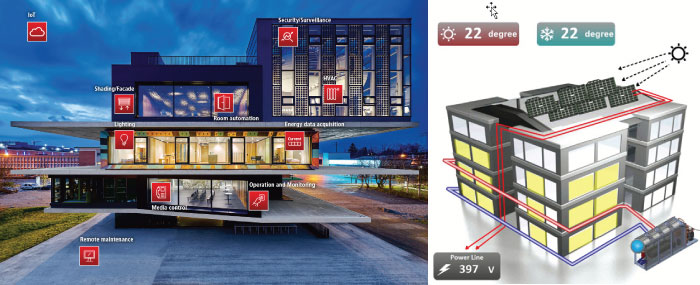BUILDING AUTOMATION

Building automation is an example of a distributed control system – the computer networking of electronic devices designed to monitor and control the systems in a building.
Reference : Building automation - Wikipedia
A building management system (BMS), otherwise known as a building automation system (BAS), is a computer-based control system installed in buildings that controls and monitors the building's mechanical and electrical equipment such as ventilation, lighting, power systems, fire systems, and security systems. A BMS consists of software and hardware; the software program, usually configured in a hierarchical manner, can be proprietary, using such protocols as C-Bus, Profibus, and so on. Vendors are also producing a BMS that integrates the use of Internet protocols and open standards such as DeviceNet, SOAP, XML, BACnet, LonWorks, Modbus or KNX.
Reference : Building management system - Wikipedia
ระบบอัตโนมัติในอาคารคือการควบคุมอัตโนมัติจากส่วนกลางของ HVAC ของอาคาร (การให้ความร้อน การระบายอากาศ และการปรับอากาศ) ไฟฟ้า แสงสว่าง การแรเงา การควบคุมการเข้าออก ระบบรักษาความปลอดภัย และระบบอื่นๆ ที่เกี่ยวข้องผ่านระบบการจัดการอาคาร (BMS) หรือระบบอัตโนมัติในอาคาร (BAS) ). วัตถุประสงค์ของระบบอัตโนมัติในอาคารคือการปรับปรุงความสะดวกสบายของผู้อยู่อาศัย การทำงานอย่างมีประสิทธิภาพของระบบอาคาร การลดการใช้พลังงาน ลดต้นทุนการดำเนินงานและการบำรุงรักษา ความปลอดภัยที่เพิ่มขึ้น เอกสารแสดงประสิทธิภาพในอดีต การเข้าถึง/การควบคุม/การทำงานจากระยะไกล และวงจรชีวิตที่ดีขึ้นของอุปกรณ์และสาธารณูปโภคที่เกี่ยวข้อง . อาคารอัตโนมัติเป็นตัวอย่างของระบบควบคุมแบบกระจาย - เครือข่ายคอมพิวเตอร์ของอุปกรณ์อิเล็กทรอนิกส์ที่ออกแบบมาเพื่อตรวจสอบและควบคุมระบบในอาคาร
เว็บไซต์อ้างอิง : Building automation - Wikipedia
ระบบบริหารจัดการอาคาร (BMS) หรือที่เรียกว่าระบบอัตโนมัติในอาคาร (BAS) คือระบบควบคุมด้วยคอมพิวเตอร์ที่ติดตั้งในอาคารที่ควบคุมและตรวจสอบอุปกรณ์เครื่องกลและไฟฟ้าของอาคาร เช่น การระบายอากาศ ระบบแสงสว่าง ระบบไฟฟ้า ระบบดับเพลิง และระบบรักษาความปลอดภัย BMS ประกอบด้วยซอฟต์แวร์และฮาร์ดแวร์ โปรแกรมซอฟต์แวร์ ซึ่งโดยปกติแล้วจะกำหนดค่าในลักษณะลำดับชั้น สามารถเป็นกรรมสิทธิ์ได้ โดยใช้โปรโตคอลเช่น C-Bus, Profibus และอื่นๆ ผู้จำหน่ายยังผลิต BMS ที่รวมการใช้อินเทอร์เน็ตโปรโตคอลและมาตรฐานเปิด เช่น DeviceNet, SOAP, XML, BACnet, LonWorks, Modbus หรือ KNX
เว็บไซต์อ้างอิง : Building management system - Wikipedia
